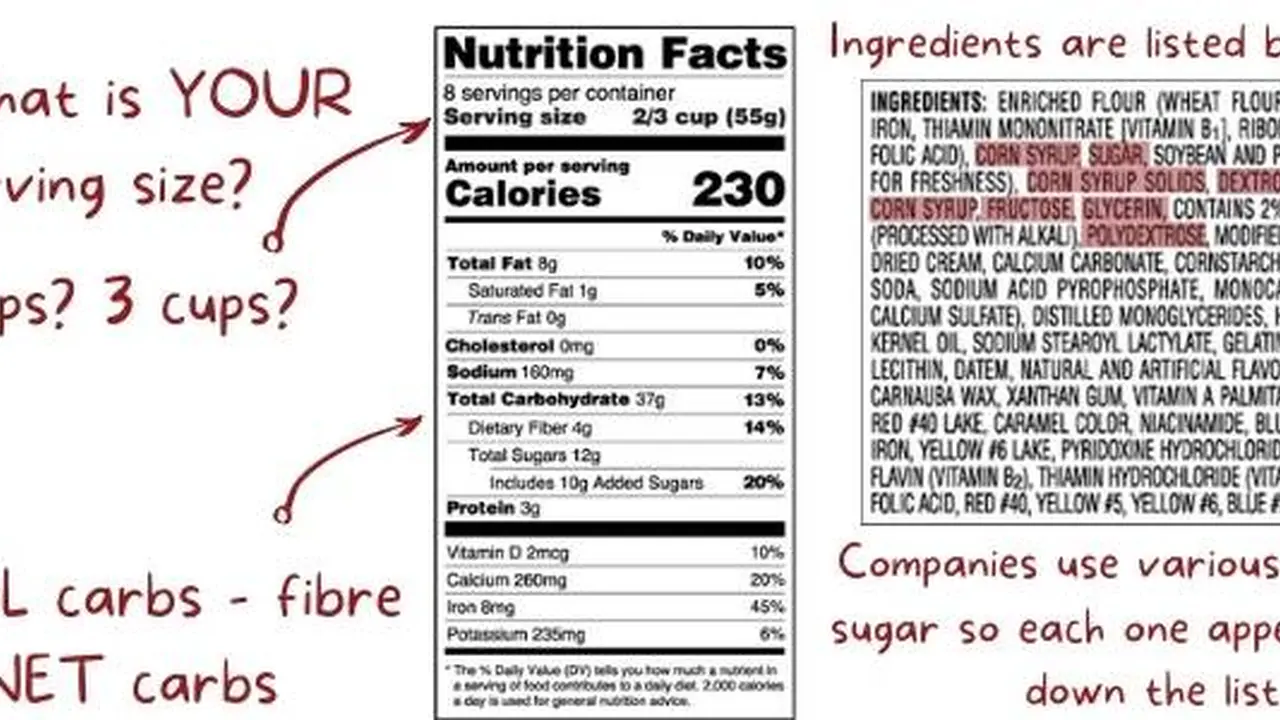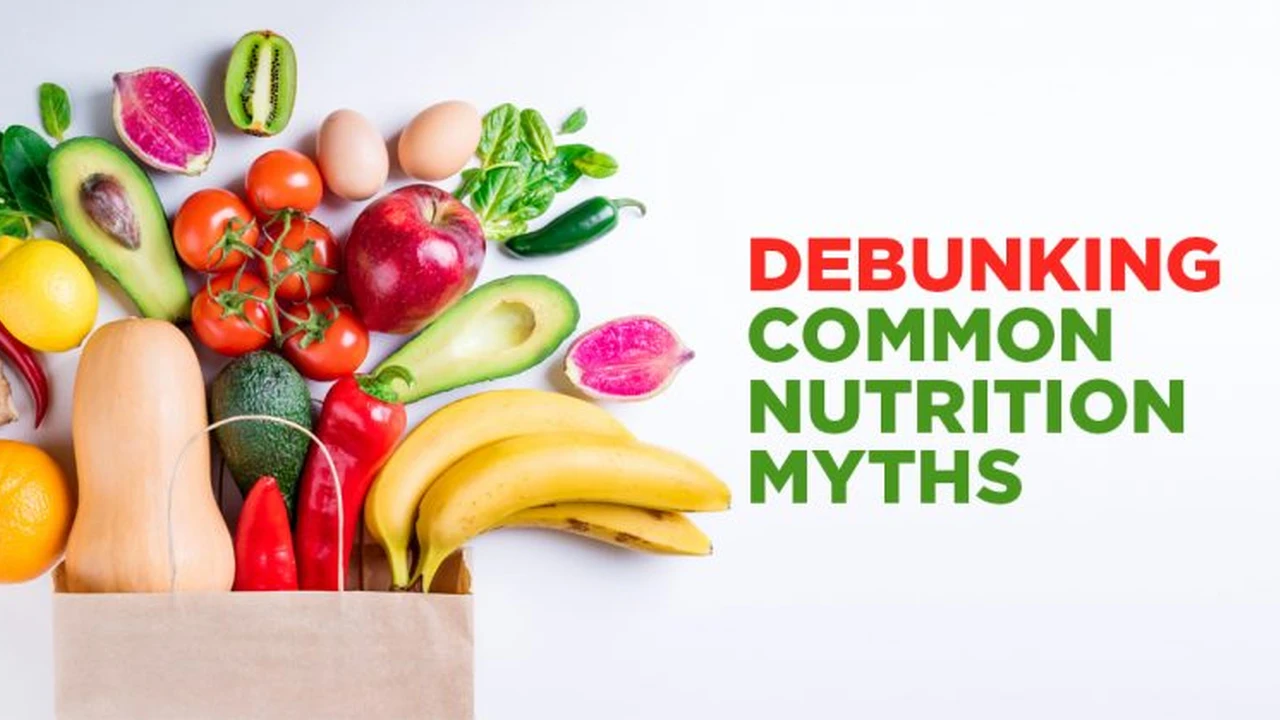How to Read Nutrition Labels Like a Pro
Understanding nutrition labels is essential for making informed food choices. This guide breaks down the key components of a nutrition label and shows you how to interpret the information effectively. Learn how to identify hidden sugars, unhealthy fats, and other important nutrients.

Decoding the Front of the Package: Claims and Marketing Gimmicks
Okay, let’s be real. The front of a food package is basically a billboard trying to grab your attention. Words like "organic," "natural," "low-fat," and "whole grain" are thrown around like confetti. But what do they actually mean? Not always what you think!
Organic: This means the product was produced following specific standards set by the USDA. It limits the use of synthetic pesticides, fertilizers, and genetically modified organisms (GMOs). However, "organic" doesn't necessarily mean "healthy." An organic cookie is still… a cookie.
Natural: This one's tricky. The FDA hasn't officially defined "natural," so it's often used pretty loosely. Generally, it implies that the product doesn't contain artificial colors, flavors, or preservatives. But again, a "natural" soda can still be loaded with sugar.
Low-Fat: To be labeled "low-fat," a product must contain 3 grams of fat or less per serving. Sounds good, right? But sometimes, when fat is removed, it's replaced with sugar or other additives to improve the taste. So, always check the sugar content!
Whole Grain: Look for the "100% Whole Grain" stamp. This means the product contains all parts of the grain kernel – the bran, germ, and endosperm. Whole grains are a good source of fiber and nutrients. However, "made with whole grains" might mean it only contains a small amount.
The takeaway? Don't be fooled by the front of the package. Always flip it over and read the nutrition label!
Navigating the Nutrition Facts Panel: Serving Size and Servings Per Container
This is where the real information lives! The first thing to look at is the serving size and servings per container. All the nutritional information on the label is based on *one* serving. If you eat twice the serving size, you're getting twice the calories, fat, sugar, etc.
Serving sizes can be misleading. For example, a bag of chips might list the serving size as 1 ounce (about 15 chips). Who eats only 15 chips? Probably no one! So, be realistic about how much you're actually eating and adjust the nutritional information accordingly.
Pay attention to the "servings per container." A small bottle of soda might seem like a single serving, but the label could say it contains 2.5 servings. If you drink the whole bottle, you're consuming 2.5 times the listed values.
Calories: Know Your Numbers for Weight Management
Calories are a measure of energy. You need a certain number of calories each day to fuel your body. Consuming more calories than you burn leads to weight gain, while consuming fewer leads to weight loss.
The nutrition label tells you how many calories are in one serving of the food. It also breaks down calories from fat. This can be helpful if you're trying to limit your fat intake. However, remember that the *type* of fat is just as important as the amount.
A general guideline is that 40 calories is low, 100 calories is moderate, and 400 calories or more is high per serving. Use this as a quick reference to assess the calorie content of a food.
Knowing your personal caloric needs is key. Factors like age, sex, activity level, and metabolism all play a role in determining how many calories you should consume each day. Consult a registered dietitian or use an online calculator to get a personalized estimate.
Total Fat, Saturated Fat, and Trans Fat: Understanding Different Types of Fats
The nutrition label lists the total fat content, as well as the amounts of saturated fat and trans fat. Understanding the difference between these types of fats is crucial for heart health.
Total Fat: This is the total amount of fat in one serving. It includes saturated, unsaturated, and trans fats.
Saturated Fat: Saturated fats are generally found in animal products like meat and dairy. They can raise LDL ("bad") cholesterol levels, increasing the risk of heart disease. Limit your intake of saturated fat.
Trans Fat: Trans fats are primarily artificial fats created during food processing. They raise LDL cholesterol and lower HDL ("good") cholesterol, significantly increasing the risk of heart disease. Trans fats are now largely banned in the US, but always check the label to make sure a product contains zero grams of trans fat.
Focus on consuming healthy unsaturated fats, such as those found in avocados, nuts, seeds, and olive oil. These fats can help lower LDL cholesterol and protect your heart.
Cholesterol and Sodium: Keep an Eye on These for Heart Health
Cholesterol and sodium are two other nutrients that are important to monitor for heart health.
Cholesterol: The nutrition label lists the amount of cholesterol in one serving. High cholesterol levels can contribute to the buildup of plaque in your arteries, increasing the risk of heart disease. Limit your intake of cholesterol, especially if you have a family history of heart disease.
Sodium: Sodium is a component of salt. High sodium intake can raise blood pressure, increasing the risk of heart disease and stroke. The American Heart Association recommends limiting sodium intake to no more than 2,300 milligrams per day for most adults, and ideally no more than 1,500 milligrams per day for those with high blood pressure.
Be mindful of hidden sources of sodium in processed foods, such as canned soups, frozen meals, and deli meats. Choose lower-sodium options whenever possible.
Total Carbohydrate, Dietary Fiber, and Total Sugars: Decoding Carbs and Sugars
The nutrition label lists the total carbohydrate content, as well as the amounts of dietary fiber and total sugars. Understanding these components is important for managing blood sugar and weight.
Total Carbohydrate: This is the total amount of carbohydrates in one serving. It includes dietary fiber, sugars, and starches.
Dietary Fiber: Fiber is a type of carbohydrate that the body can't digest. It helps regulate blood sugar levels, promotes digestive health, and can help you feel full and satisfied. Aim for a high-fiber diet.
Total Sugars: This includes both naturally occurring sugars (like those in fruits and milk) and added sugars (like those in processed foods). Added sugars provide calories but little nutritional value. Limit your intake of added sugars.
Focus on consuming complex carbohydrates, such as whole grains, fruits, and vegetables. These carbohydrates are digested slowly, providing a steady stream of energy and helping to regulate blood sugar levels.
Added Sugars: The New Kid on the Block (and Why You Should Care)
The FDA recently added "Added Sugars" to the nutrition label, making it easier to identify how much sugar has been added to a product during processing. This is a game-changer!
Added sugars can be disguised under many different names, such as high-fructose corn syrup, sucrose, glucose, and dextrose. Learning to recognize these names can help you identify hidden sources of added sugar.
The American Heart Association recommends limiting added sugar intake to no more than 6 teaspoons (25 grams) per day for women and 9 teaspoons (36 grams) per day for men.
Protein: Essential for Building and Repairing Tissues
Protein is essential for building and repairing tissues, as well as for producing enzymes and hormones. The nutrition label lists the amount of protein in one serving.
The recommended daily intake of protein varies depending on factors such as age, sex, and activity level. A general guideline is 0.8 grams of protein per kilogram of body weight.
Good sources of protein include lean meats, poultry, fish, beans, lentils, tofu, and nuts.
Vitamins and Minerals: Essential Nutrients for Overall Health
The nutrition label lists the percentages of the Daily Value (DV) for certain vitamins and minerals, such as vitamin D, calcium, iron, and potassium. These are essential nutrients for overall health.
The DV is a reference value for the amount of a nutrient that most people need each day. A food that provides 20% or more of the DV for a nutrient is considered a good source of that nutrient.
Pay attention to the vitamin and mineral content of foods, especially if you have any dietary restrictions or health concerns.
Ingredient List: A Hidden Gem of Information
Don't overlook the ingredient list! It lists all the ingredients in a food, in descending order by weight. This can give you valuable insights into the quality of the food.
Look for whole, unprocessed ingredients at the top of the list. Avoid foods with long lists of artificial ingredients, preservatives, and additives.
The ingredient list can also help you identify potential allergens. Common allergens, such as milk, eggs, peanuts, tree nuts, soy, wheat, and fish, must be listed on the label.
Practical Tips for Using Nutrition Labels to Make Healthy Choices
- Compare products: Use nutrition labels to compare similar products and choose the healthier option.
- Plan your meals: Use nutrition labels to plan your meals and ensure you're getting a balanced diet.
- Track your intake: Use nutrition labels to track your intake of calories, fat, sugar, and other nutrients.
- Be mindful of portion sizes: Pay attention to the serving size and adjust your intake accordingly.
- Don't be fooled by marketing claims: Always read the nutrition label to get the real information.
Product Recommendations: Making Informed Choices with Specific Examples
Let's look at some specific examples to illustrate how to use nutrition labels to make healthier choices:
Cereal Comparison: General Mills Cheerios vs. Kellogg's Frosted Flakes
Cheerios: 1 serving (1 cup) contains 100 calories, 2g total fat (0g saturated fat), 0mg cholesterol, 140mg sodium, 20g total carbohydrate (3g fiber, 1g total sugars, 1g added sugars), and 3g protein. The ingredient list is simple: Whole grain oats, corn starch, sugar, salt, tripotassium phosphate, wheat starch, vitamin E (mixed tocopherols) added to preserve freshness.
Frosted Flakes: 1 serving (1 1/4 cups) contains 110 calories, 0g total fat, 0mg cholesterol, 125mg sodium, 26g total carbohydrate (1g fiber, 24g total sugars, 24g added sugars), and 1g protein. The ingredient list includes: Milled corn, sugar, malt flavor, contains 2% or less of salt, vitamins and minerals: iron, vitamin C, vitamin B6, vitamin B2, vitamin B1, folic acid, vitamin D3, vitamin B12.
Analysis: Cheerios is the clear winner here. It's lower in calories, sodium, and sugar, and higher in fiber. Frosted Flakes is loaded with added sugar, providing little nutritional value. Cheerios are available for around $4 per box, while Frosted Flakes are around $3.50 per box.
Usage Scenario: Cheerios are a great everyday breakfast option. Frosted Flakes are more of a treat.
Yogurt Showdown: Greek Yogurt vs. Regular Yogurt
Chobani Plain Greek Yogurt (0% fat): 1 container (5.3 oz) contains 100 calories, 0g total fat, 0mg cholesterol, 65mg sodium, 7g total carbohydrate (0g fiber, 5g total sugars, 0g added sugars), and 18g protein. The ingredient list is simple: Cultured pasteurized nonfat milk.
Dannon Regular Yogurt (Vanilla): 1 container (5.3 oz) contains 140 calories, 1.5g total fat (1g saturated fat), 10mg cholesterol, 75mg sodium, 25g total carbohydrate (0g fiber, 19g total sugars, 14g added sugars), and 7g protein. The ingredient list includes: Cultured grade A reduced fat milk, sugar, modified corn starch, water, contains less than 1% of kosher gelatin, natural and artificial flavor, citric acid, potassium sorbate added to maintain freshness, vitamin D3.
Analysis: Greek yogurt is the healthier choice. It's lower in calories, sugar, and carbohydrates, and significantly higher in protein. Regular yogurt is higher in added sugar and contains artificial flavors. Chobani Greek Yogurt is typically priced around $1.50 per container, while Dannon Regular Yogurt is around $1.00 per container.
Usage Scenario: Greek yogurt is a great base for smoothies, parfaits, or as a standalone snack. Regular yogurt can be used similarly, but be mindful of the added sugar.
Bread Battle: Whole Wheat Bread vs. White Bread
Ezekiel 4:9 Sprouted Whole Grain Bread: 1 slice contains 80 calories, 0.5g total fat (0g saturated fat), 0mg cholesterol, 75mg sodium, 15g total carbohydrate (3g fiber, 0g total sugars, 0g added sugars), and 4g protein. The ingredient list is: Organic sprouted wheat, filtered water, organic sprouted barley, organic sprouted millet, organic malted barley, organic sprouted lentils, organic sprouted soybeans, organic sprouted spelt, sea salt.
Wonder Bread Classic White Bread: 1 slice contains 70 calories, 1g total fat (0g saturated fat), 0mg cholesterol, 135mg sodium, 13g total carbohydrate (1g fiber, 2g total sugars, 0g added sugars), and 2g protein. The ingredient list includes: Enriched wheat flour [flour, malted barley flour, reduced iron, niacin, thiamin mononitrate (vitamin B1), riboflavin (vitamin B2), folic acid], water, high fructose corn syrup, yeast, soybean oil, salt, monoglycerides, calcium propionate (preservative), calcium sulfate, datem, soy lecithin.
Analysis: Ezekiel bread is far superior. It's packed with whole grains, fiber, and protein, and contains no added sugar or artificial ingredients. White bread is made with refined flour and contains high fructose corn syrup. Ezekiel bread is more expensive, typically around $5 per loaf, while Wonder Bread is around $3 per loaf.
Usage Scenario: Ezekiel bread is ideal for sandwiches, toast, or avocado toast. White bread is less nutritious and should be consumed in moderation.
Final Thoughts: Empowering Yourself with Knowledge
Reading nutrition labels might seem daunting at first, but it's a skill that can empower you to make healthier choices and take control of your well-being. By understanding the key components of the nutrition label, you can make informed decisions about the foods you eat and create a diet that supports your health goals. So, next time you're at the grocery store, take a few extra minutes to read the labels and choose wisely. Your body will thank you!
:max_bytes(150000):strip_icc()/277019-baked-pork-chops-with-cream-of-mushroom-soup-DDMFS-beauty-4x3-BG-7505-5762b731cf30447d9cbbbbbf387beafa.jpg)






